Constructed wetlands, natural water purification systems
Constructed Wetlands in practice
There are various types of structures that can be used for Constructed Wetlands depending on the different needs and according to a set goal for breaking down pollutants.
The following system types have produced the most satisfying results in terms of levels of purification, hygienic and health impact, operating simplicity and adaptability to the various environmental conditions:
- Horizontal Subsurface Flow Systems
- Vertical Subsurface Flow Systems
- Surface Flow Systems
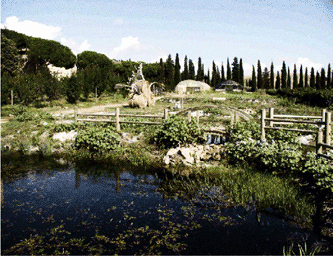
Surface free flow system (FWS) for the treatment and collection of rainwater to be re-used (Grosseto, Italy)
HORIZONTAL SUSURFACE FLOW SYSTEMS
(SFS-h)
The SFS-h look like basins dug into the earth, about one metre deep and rendered impermeable by a synthetic membrane stretched across the bottom. The basin is filled with inert materials, usually fine gravel and crushed stone, whose granulometry is carefully selected to allow for optimal diffusion of the effluent waters in the basin.
The waste water is introduced into the system via a perforated pipe running the crosswise length of the basin and it then filters slowly through the filling thanks to a slight tilt (between 1 and 5 percent) in the base of the basin. The water always remains under the surface until reaching a drainage pipe that allows it to exit the system.
Aquatic plants from the Phragmites, Thypa and Scirpus genera are commonly cultivated in the systems, with their roots developing in the filling medium. The plants act as natural pumps for transferring oxygen from the atmosphere into the filling medium of the basins, which is inhabited by bacterial colonies capable of decomposing organic material under aerobic conditions and nitrifying it. Ideal anaerobic conditions for the de-nitrification process exist in areas furthest from the roots.
These systems are capable of destroying 99 percent of the microbe load, in particular pathogen bacteria. In addition, the plants absorb any metal present in the waste water, while the filling inerts allow for removal of phosphorous through fixing.
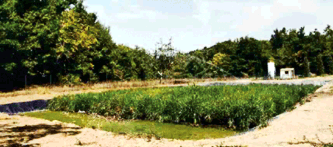
Horizontal subsurface flow system (used as a tertiary treatment)
VERTICAl SUBSURFACE FLOW SYSTEMS (SFS-v)
The SFS-v are distinguished from the Horizontal Subsurface Flow Systems by the fact that the effluent waters are distributed within the basins intermittently and the hydraulic flow is predominantly vertical.
Another difference is the use of a different type of filling medium made up of several layers of various grades of gravel and sand, from a layer of sand at the surface through to a layer of stones laid over the drainage system at the bottom.
The vertical system's method of feeding into the system by sprinkling allows for more oxygen to be introduced into the effluent waters and thereby for improved capacity to break down organic material.
In these systems as well, the waters remain under the surface of the basin and the same plants are used as for the horizontal flow systems.
SURFACE FREE FLOW SYSTEMS (FWS)
These consist of a shallow basin waterproofed with a synthetic membrane in which the waters run freely at the surface. They vary in height between a few centimetres and one metre.
The system is conceived in such a way as to create the appropriate environments for a variety of plants, from aquatic plants that live underwater to floating plants, from helophytes plants that live on the banks to hydrophile plants with exposed roots.
Vegetation is chosen according to a series of criteria that allow for the most faithful possible reproduction of the biodiversity of a naturally wet area while guaranteeing maximum purification potential.
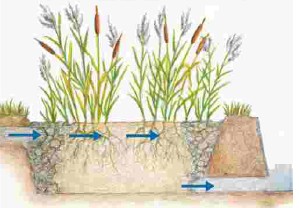
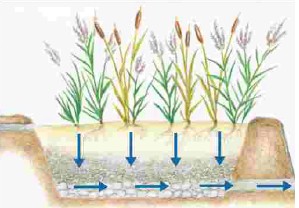
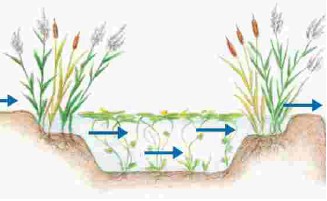
Schematic illustration of a horizontal
subsurface flow system (above),
a vertical subsurface flow system (middle)
and of a free flow system (bottom)
Each species of vegetation performs a series of specific functions within the system. These include oxygenating the water in which they are found and absorbing nutritive substances (phosphate, nitrate, etc.) present there that are necessary for the plants' growth. All kinds of plants provide a suitable substratum that foster the development of micro organisms important for the purifying processes of naturally wet areas.
The vegetation commonly used for these systems belong to the genera Phragmites, Typha, Scirpus, Iris, Nymphaea, Juncus, Carex, Alisma, Myriophyllum, Ceratophyllum, Butomus, Potamogetum, etc. In any case it is good practice to use autoctonous plants that do not alter the natural environment and are not detrimental or invasive to the neighbouring areas.
DOWNLOAD THE BROCHURE PDF
english (1.0 MB)spanish (0.7 MB)
albanian (0.4 MB)








 COUNTRY OF ORIGIN
COUNTRY OF ORIGIN OUTSTANDING IDEASS PROJECTS
OUTSTANDING IDEASS PROJECTS